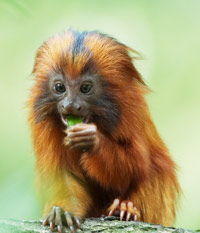|
 Small and golden: Lion tamarins weigh up to 900 grams (2 pounds) and are about 30 cm (12 inches) long, with tails about 45 cm (17 inches) long. They are monomorphic - the males and females are the same size and look the same. Their fur is long and goes from a pale gold color to a richer red-gold color. There are black markings on the feet and tail. The fur is rather soft and silky, similar to a young cat's fur. The way the fur is around their face, like a big mane, their face looks like a lions - and that's where their name comes from! Small and golden: Lion tamarins weigh up to 900 grams (2 pounds) and are about 30 cm (12 inches) long, with tails about 45 cm (17 inches) long. They are monomorphic - the males and females are the same size and look the same. Their fur is long and goes from a pale gold color to a richer red-gold color. There are black markings on the feet and tail. The fur is rather soft and silky, similar to a young cat's fur. The way the fur is around their face, like a big mane, their face looks like a lions - and that's where their name comes from!
They have narrow, long hands and feet. Their elongated fingers are as long as their forearms! On the hand, the three middle fingers are attached to a central joint by a skin fold. They have non-opposable thumbs.

 Trees in Brazil: Living in the eastern tropical rainforests of Brazil, like all other callitrichines they are arboreal.
They prefer humid areas with a closed canopy and lots of vines. Trees in Brazil: Living in the eastern tropical rainforests of Brazil, like all other callitrichines they are arboreal.
They prefer humid areas with a closed canopy and lots of vines.
Jumping for insects: Golden lion tamarins are very agile and can leap and jump from branch to branch easily with their extremely strong legs. . They prefer moving in a horizontal direction but are also good at climbing on tree trunks because of their claw-like nails. They jump through trees using their fingers to hold onto branches and their claws to dig under the bark to search for insects to eat. They also eat some snakes, plants, small lizards and small, sweet and pulpy fruits.
Soft calls: The tamarin, in addition to being very active, is also very vocal. Perhaps as an adaptation to stay hidden from predators like eagles and hawks, all their vocalizations are very soft (other than their squeal of alarm).
 Family Tamarin: Lion tamarins tend to live in family groups, with both parents sharing different tasks of child-rearing the yearly twins. The parents are monogamous. The mother nurses her young every two to three hours, and the father carries the babies on his back. Family Tamarin: Lion tamarins tend to live in family groups, with both parents sharing different tasks of child-rearing the yearly twins. The parents are monogamous. The mother nurses her young every two to three hours, and the father carries the babies on his back.
Day time tree hoppers: Diurnal tree-dwellers, they sleep in tree cavities at night, and also seek shelter during the hottest part of the day. The cavities have entrances that are too small for many predators to enter. They mark their territory boundaries with scent glands located on their chests and genitals.
 
Little lion primates in big trouble: Lion Tamarins are critically endangered. Their habitat used to be much larger. Their body adapted specifically for their environment of dense, primary forest, so there is a great concern over their future, because 99% of the primary forests have been cut down for housing,lumber, pastures, and agriculture.
Also the tamarin's beautiful mane was valued target by poachers wanting to sell it on the black market. Before 1960, they were also exploited in the pet trade, zoos and laboratories.
Baboon | Howler Monkey | Mandrill | Marmoset | Patas Monkey | Squirrel Monkey
Primates| Apes| Monkeys| Prosimians
All text is available under the terms
of the GNU Free Documentation License
|